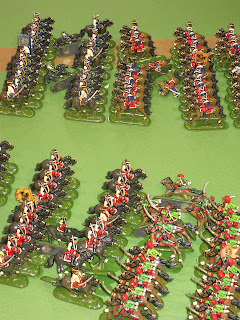With an opponent unfortunately having to postpone a gaming session and my painting mojo running low, I thought I'd make a quick post on some of the tools I make for my games.
First off, an example of my fondness for peg-boards, are my 'What a Cowboy' (WaC) peg-boards as used in a recent game.
This was just made from two layers of fairly thick card glued together, although I would be tempted, if making this now, to use magnetic tiles as the cardboard ones are a fairly tight fit. As you can see, the tiles, numbered 1-25 are randomised both as to placement and orientation. The players in the game move around a grid with the numbers reading from left to right and all oriented in the same way, thus when they leave a square through a given side only the umpire can tell them which side of which square they enter.
The grand-daddy of them all, at the top, complete with its bespoke die, is a roundshot bounce stick for Charles Grant's 'The War Game' rules. The rest are made for the reduced scale I use in my much tweaked (butchered?) version of Brigadier Peter Young's 'Charge' rules. For these I equate 1" to 2cm as the 'Charge' movement distances and artillery ranges are too generous for my sub-sized table (sub-sized that is compared to Charles Grant's 9'x7' table on which most of the games seem to have been played).























